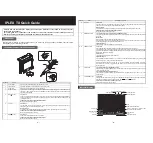
<6. PARAMETER DESCRIPTION>
6-34
IM 01E30D01-01EN
[J22: Dead Time]
Setting of dead time
This parameter sets the time for application of the
rate limit, and if a value of 0 is set, the rate limit
function will be terminated.
NOTE
Determining rate limit value and dead time
F0611.ai
T
0
T
0
2%
2%
Rate limit value:
Determines the level for
output fluctuation cutoff. For
example, if this is set to 2%,
noise above 2% will be
eliminated as shown in the
diagram.
Dead time (T
0
):
This is to be determined using
the output fluctuation width. If
noise exceeds the dead time
as shown in the diagram
below, the dead time should
be made longer.
●
Signal processing method:
A fixed upper and lower limit value is setup with
respect to the primary delay response value for
the flow rate value obtained during the previous
sampling, and if the currently sampled flow rate
is outside these limits, then the corresponding
limit is adopted as the current flow rate value.
In addition, if signals which breach the limits in
the same direction occur over multiple samples
(i.e., within the dead time), it is concluded that
the corresponding signal is a flow rate signal.
Example 1: Step input
F0612.ai
10
%
1
%
Step signal
Flow rate value
after rate limit
processing
63.2
%
100
225
Dead time: 3 s
Input: 0 to 10%
Damping time constant: 5 s
Dead time: 3 s
Rate limit value: 1%
Number of signal samples
Flow rate value after
damping
(a)
(b)
(c)
(d)
(1) In comparison with the previous value at (a), it
is determined that the signal is in excess of the
rate limit value and the response becomes 1%.
However, the actual output applies damping,
and therefore the output turns out to be as
indicated by the solid line.
(2) Subsequent flow values within the dead time
zone correspond to signals of post-damping
flow value + rate limit value (1%).
(3) Since input signals do not return to within
the rate limit value during the dead time, it is
determined at (c) that this signal is a flow rate
signal.
(4) The output signal becomes a damped curve
and compliance with the step signal begins.
Five seconds after determination of a flow rate
signal in the above figure, a level of 63.2% is
reached.
Example 2: Slurry noise
F0613.ai
+1
%
-1
%
Dead time: 1 s
Flow rate value after damping
Flow rate value
after rate limit
processing
Slurry noise
Input: 0 to 10%
Damping time constant: 1 s
Dead time: 1 s
Rate limit value: 1%
Time
In the figure on the left, it
is determined that the
slurries noise signal is not
a flow rate signal.
[J23: Pulsing Flow]
Selection of pulsing flow
support
In a situation where pulsating flow causes error in
the average flow value, due to the application of a
plunger pump, this parameter provides functionality
whereby calculation is controlled and variations in
flow rate are followed.
Setting
Function
No
Normal
Yes
Support for
pulsing flow
[J25: T/P Damp Select]
Setting of damping
operation
This parameter is used to select that the flow rate
value obtained through damping calculation for
totalization and pulse output or the instantaneous
flow rate value (no damping) for totalization and
pulse output.
Setting
Function
Damp
Damping
No Damp
No damping
















































